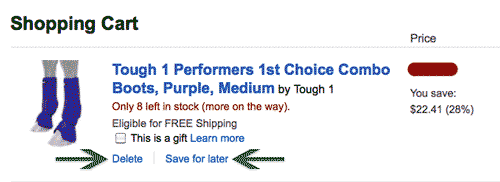Western Spurs
A Western-style of spur (aka, the type of spur with a rowel) are believed by most historians to have originated in France or Spain in the 10th Century AD.
However, roweled spurs, for whatever reason, did not come into wide use until the 14th Century. You can find out more about the history of Western spurs a little lower on this page, underneath the spurs for sale.
Below: A Western spur on a cowboy.

Below: A classic Western spur with antique finish and German silver. From Amazon.

Western Spurs With Antiqued Finish and Engraved German Silver
From eBay and Amazon
See more Western spurs on eBay
See more Western spurs on Amazon
Items On (Some) Western Spurs
Some Western spurs have chap guards and/or jingle bobs. So, what are those?
- A chap guard is a small, upward curving hook on the back of some Western spurs (see the blue arrow in the image below). It is located on the spur's shank in front of the rowels. It's purpose is to keep chaps, if the rider is wearing them, from interfering with the rowels.
- Jingle bobs are small pieces of metal that dangle from a spur's rowels (see the yellow arrow in the image below). Their purpose is to jingle, or make a small ringing sound.
Below: The blue arrow is pointing to a chap guard. The yellow arrow is pointing to jingle bobs.

A Brief History of Western Spurs
While there is much speculation about the earliest forms of spurs, a great deal is not actually known. Many historians believe there were very early forms of spurs made from wood and/or bone.
It was not until spurs were made of metal that their history became somewhat easier to trace. Metal spurs were believed to have been used by the Roman Legions of Julius Caesar (who lived from 100 BC to 44 BC), and spurs from the 2nd Century BC have been found in the famous Etruscan tombs of Northern Italy.
Early spurs did not have rowels like the most well-recognized Western spurs do today. Instead, they simply had one prong and little or no neck. Spurs with rowels are believed by most historians to have originated in France or Spain in the 10th Century AD, but roweled spurs, for whatever reason, did not come into wide use until the 14th Century.
Spurs came to the Americas with the Spanish, dating back to the conquistadores arriving in the 1500's. In those days, the spurs that would eventually evolve into the modern Western spur worn by cowboys had a rowel that was 6 to 8 inches around. Appropriately enough, it was called "The Espuela Grande" which means "The Great Spur."
Over time, spurs made their way to what is now Mexico and the United States and became more refined for the newly emerging lifestyle of the Vaquero, and a little later the cowboy.
The modern Western spurs worn by cowboys and cowgirls have been used as much for displaying artistry and fine craftsmanship as they have been for a riding aid. Western spurs are frequently decorated with names, brands, initials, a wide range of symbols, engraving, inlays, or other ornamentation. They can come in colors, with large rowels, small rowels, and no rowels at all, or in virtually any other variation the rider would like.
A customized Western spur with the name "Levi."

Spurs - Fun Stuff To Know
During Medieval time spurs became a recognizable way of determining a man's rank or status.
- A knight would have spurs made of gold (a knight was a man, usually of good birth, trained in chivalry and fighting skills).
- An esquire's spurs would be made of silver (an esquire was a young man of good birth who aspired to be a knight, and who attended a knight).
- A man-at-arms' spurs would have been made of iron or brass (a man-at-arms was a soldier who lacked the social status of a knight).
Save The Spurs For Later
If you find a set of spurs you like on Amazon but you're not ready to purchase them right away, you can always add them to your shopping cart so they will be easy to find later.
- In most cases, Amazon will keep track of your spurs, and anything else in your shopping cart, for 90 days.
- Later on, if you decide you don't want the spurs after all, it's easy to click "delete" and remove them from your cart.
- In the meantime, if you want to check out with other items, click "Save for later" to move the chinks to a separate, but still easy-to-find list beneath your shopping cart.
Important: Putting items in your Amazon shopping cart or "Save for later" list does NOT reserve them! It just makes them easier to find if they're still in stock when you come back.
Below: Screenshot image showing the "delete" and "Save for later" links when an item is in the Amazon shopping cart.

You Might Also Like...